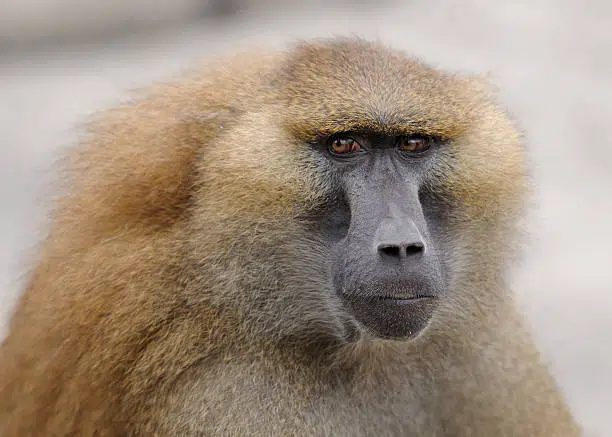Table of Contents
Scientific Classification
| Kingdom | Animalia |
| Phylum | Chordata |
| Class | Mammalia |
| Order | Primates |
| Family | Cercopithecidae |
| Genus | Papio |
| Species | P. papio |
| Scientific Name | Papio papio |
Description
The Guinea baboon may be the smallest among the five baboon species, but it certainly makes a big impression with its unique charm and intricate behaviors. These fascinating primates sport a beautiful coat that ranges from golden to reddish-brown. Typically, males are larger and more robust than females, showcasing a slender body and a long, dog-like muzzle—an iconic feature of baboons. Their faces, hands, and feet are dark and devoid of hair, while males sport a small, flattened mane around their necks.
You can really see the differences between the sexes in this species. Males are noticeably bigger and have longer canine teeth, which they proudly display during dominance postures. What sets the Guinea baboon apart from its relatives is its shorter tail, which arches in a distinctive way as it walks. With their expressive eyes and engaging social behaviors, these baboons truly have a captivating personality.
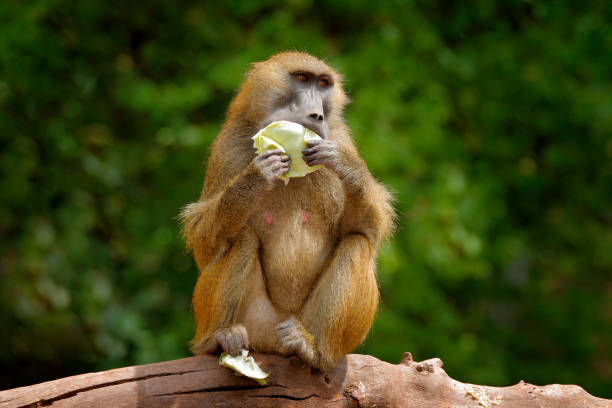
Distribution
The Guinea baboon boasts one of the most limited geographic ranges among all baboon species. They primarily inhabit western Africa, covering countries like Guinea, Senegal, Gambia, southern Mauritania, and western Mali. Their territory is a slender strip along the savannah just south of the Sahara Desert, making them the only baboon species predominantly found in West Africa.
While their range may be small, they show impressive adaptability to their surroundings. You can spot them in protected areas as well as near human settlements.
Habitat
Baboons are incredibly adaptable creatures, finding their homes in a variety of habitats. They can really thrive in semi-arid regions where vegetation is sparse, but having access to water is essential for their survival.
Guinea baboons often search for food in woodlands, taking breaks under the thick canopies of trees and sipping from nearby rivers. They’re quite skilled at climbing trees, whether it’s to catch some sleep or to escape from predators. However, during the day, they prefer to stay grounded.
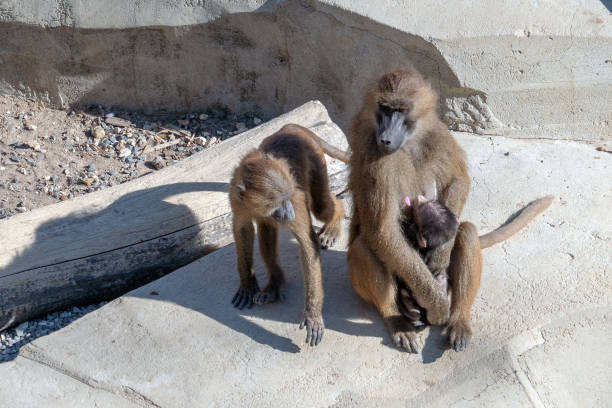
Diet
Guinea baboons eat both plants and animals. This helps them make the most of the food around them. Their diet is highly flexible and includes:
- Fruits
- Seeds
- Roots
- Leaves
- Insects
- Small vertebrates
They often raid farms near human homes. They eat crops like maize, millet, and peanuts. This sometimes brings them into conflict with local farmers. They help spread seeds and control insects. This keeps their native habitats balanced.
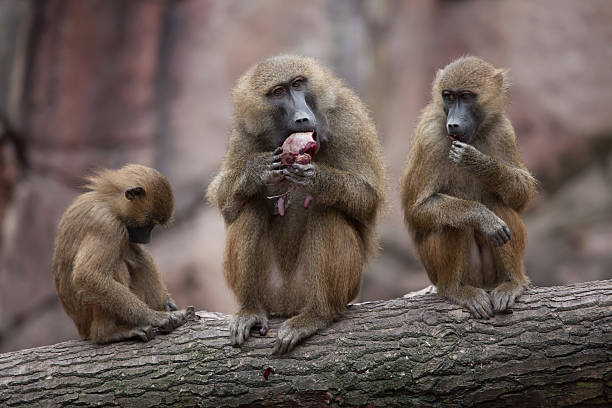
Behavior
The Guinea baboon showcases some of the most fascinating social dynamics among its kind. They form large, fluid groups known as troops, which can consist of up to 200 individuals. Within these sizable troops, you’ll find various subgroups, including “units” that are typically led by a dominant male, accompanied by several females and their young ones.
Social interactions are vital to baboon life. Grooming is a key activity that helps strengthen bonds and establish social hierarchies. Males often forge alliances, while females tend to nurture strong relationships based on kinship.
What sets Guinea baboons apart from other baboon species is their remarkable tolerance. They tend to cooperate better than many of their more aggressive counterparts, who often live under strict hierarchies. Males are generally less aggressive, allowing them to share space and mates without constant conflict. This more harmonious way of living makes them particularly interesting for researchers in the field of primatology.
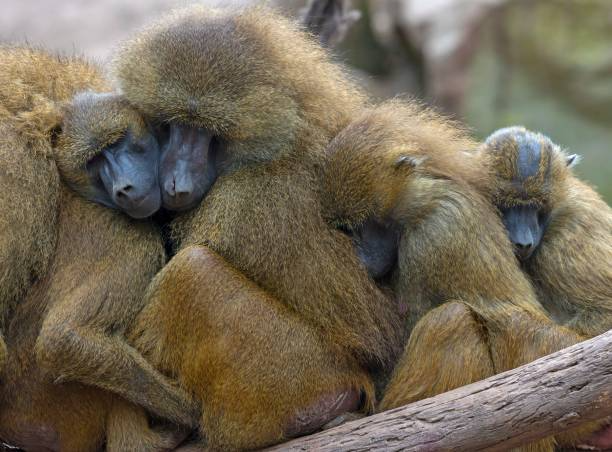
Lifespan
In the wild, Guinea baboons usually have a lifespan of about 20 to 25 years. However, when they’re in captivity, where they face fewer dangers from predators and diseases, they can live for 30 years or even longer.
Several factors play a role in how long they live, including the availability of food, threats from predators, diseases, and their social standing. Infants and young baboons are particularly vulnerable, often facing higher risks of predation or abandonment, especially during times when food is hard to come by.
Reproduction and Lifecycle
When it comes to reproduction, guinea baboons don’t stick to a strict breeding season. Most of the time, though, you’ll find that births coincide with the rainy season when food is plentiful. The females make it pretty obvious when they’re in estrus, showing noticeable swelling and redness around their genital area, which signals their fertility to the males nearby.
After a female becomes pregnant, she goes through a gestation period of about six months. Typically, she gives birth to a single infant, which usually has a black face and a pinkish tint that changes as it matures. The mother carries her baby either clinging to her chest or riding on her back, nursing it for several months.
For the first few months, infants rely heavily on their mothers. As they grow, they start to venture out and interact with other members of the troop. Weaning usually occurs around the age of one year. As juveniles, they gradually find their place within the troop’s social structure. Females reach sexual maturity at around 4 to 5 years, while males typically mature a bit later, at about 6 to 8 years.
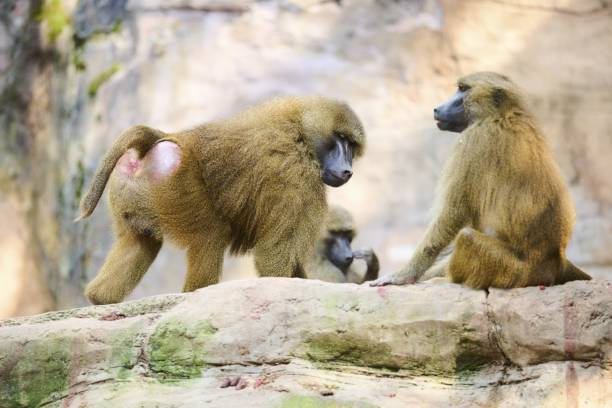
Predators
Guinea baboons face many natural predators. This is especially true in thick vegetation, where there are few escape paths. The primary predators include:
- Leopards
- Lions
- African wild dogs
- Hyenas
- Large raptors (particularly for juveniles)
Baboons respond to threats by sticking together. They use their numbers, make alarm calls, and defend each other. Males often place themselves between the troop and danger. They use their big canines to scare off attackers.
Adaptations
Guinea baboons have developed several fascinating adaptations that help them thrive in tough environments:
Social Intelligence: Their complex social behaviors foster flexible group dynamics and encourage cooperation among members.
Strong Limbs: These powerful limbs are perfect for moving on the ground and making quick escapes into trees, giving them a real edge.
Keen Senses: With sharp vision and acute hearing, they can easily spot potential predators lurking nearby.
Cheek Pouches: These handy pouches allow them to store food temporarily while foraging, which helps them stay safe.
Coloration: Their reddish-brown fur blends seamlessly into dry grasslands and forests, providing excellent camouflage.
All these adaptations play a crucial role in helping Guinea baboons survive against natural threats and the challenges posed by human encroachment.
Mating Season
Guinea baboons can mate throughout the year, but most of their babies are born at the beginning of the rainy season. This timing seems to be their preferred choice for giving birth, as it coincides with an abundance of food. Having plenty of resources available supports breastfeeding and helps keep the little ones safe and healthy.
During mating season, males tend to groom the females more and stick close to them. This behavior showcases their strength and dominance, although they are generally less aggressive compared to other baboon species.
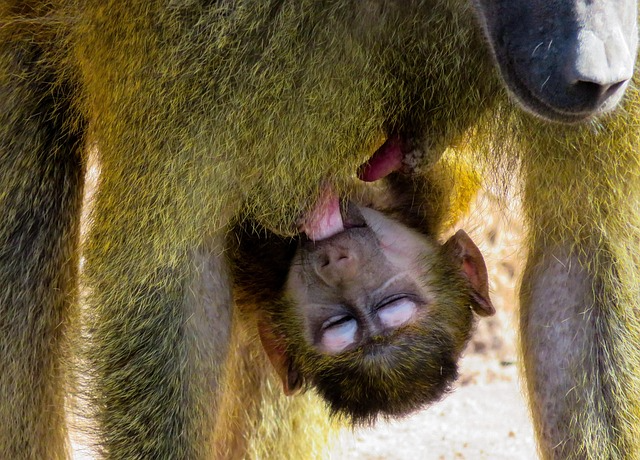
Breeding
The mating process is a fascinating dance of social and physical signals. When a male forms a connection with a female in estrus, they often mate several times over a few days. While this bond is usually temporary, it can extend if the male provides consistent protection or grooming.
Females have the opportunity to mate with multiple males during their reproductive cycle, which enhances genetic diversity. In large troops, paternity can be a bit of a mystery. This ambiguity might actually result in lower rates of infanticide compared to more hierarchical baboon groups.
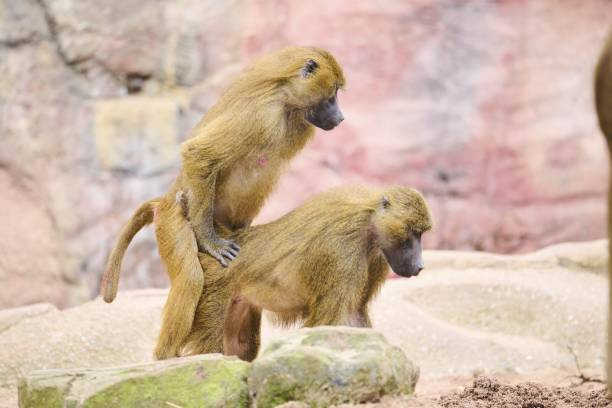
Interesting Facts
- Did you know some fascinating facts about guinea baboons? These creatures have a surprisingly calm social structure, making them less aggressive compared to other baboon species. This peaceful nature fosters a more tolerant and united community.
- When it comes to communication, they have quite the vocal range! From barks to grunts and even screams, they express themselves in various ways.
- Being diurnal, these baboons are active during the day and can cover impressive distances—up to 10 kilometers daily—while searching for food.
- At night, they often retreat to the same tall trees for safety and rest, creating a cozy routine for their troops.
- Their facial expressions are quite telling too; they can convey emotions like fear, submission, or contentment just through their faces.
- Interestingly, guinea baboons play a vital role in forest regeneration. By eating and then dispersing seeds through their droppings, they help the ecosystem thrive.
- Some of these baboons even live close to human settlements, scavenging or foraging without much fear of people.
- And here’s a fun fact about the males: as they grow older, their reddish manes become more pronounced, which is thought to signify strength and maturity.
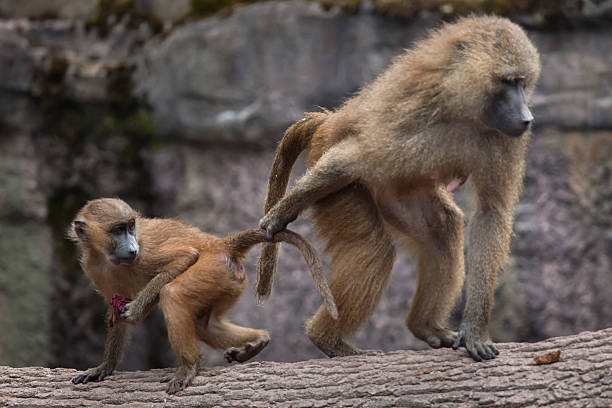
Conservation Status
The conservation status of the Guinea baboon is currently classified as “Near Threatened” on the IUCN Red List. While they remain relatively common in their habitats, their populations are under threat from several factors:
– Habitat loss caused by agriculture and urban development
– Hunting for bushmeat or traditional medicine
– Conflicts with humans, particularly near agricultural areas
Fortunately, conservation initiatives are underway in certain regions, especially within protected parks. A prime example is Niokolo-Koba National Park in Senegal, which plays a crucial role in their preservation. It’s essential that we continue to monitor their status and raise awareness in local communities to ensure the survival of this remarkable West African primate.
The Guinea baboon is more than just a social creature; it also demonstrates adaptability, intelligence, and resilience in the face of ecological challenges. Their harmonious societies offer valuable insights into baboon behavior and the evolution of social structures. By protecting this incredible species, we help preserve Africa’s rich primate heritage.



